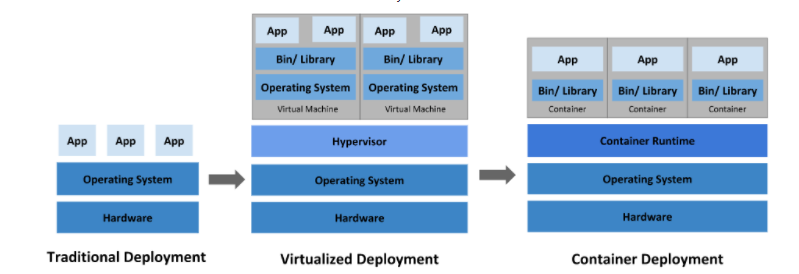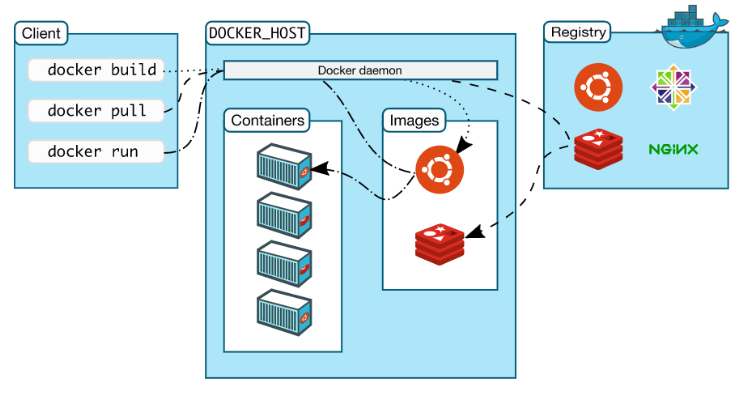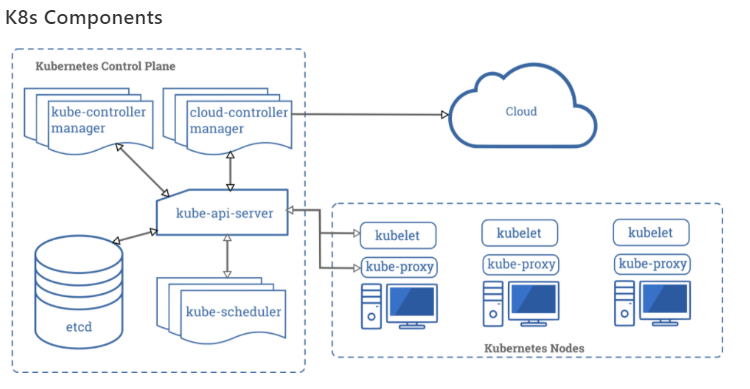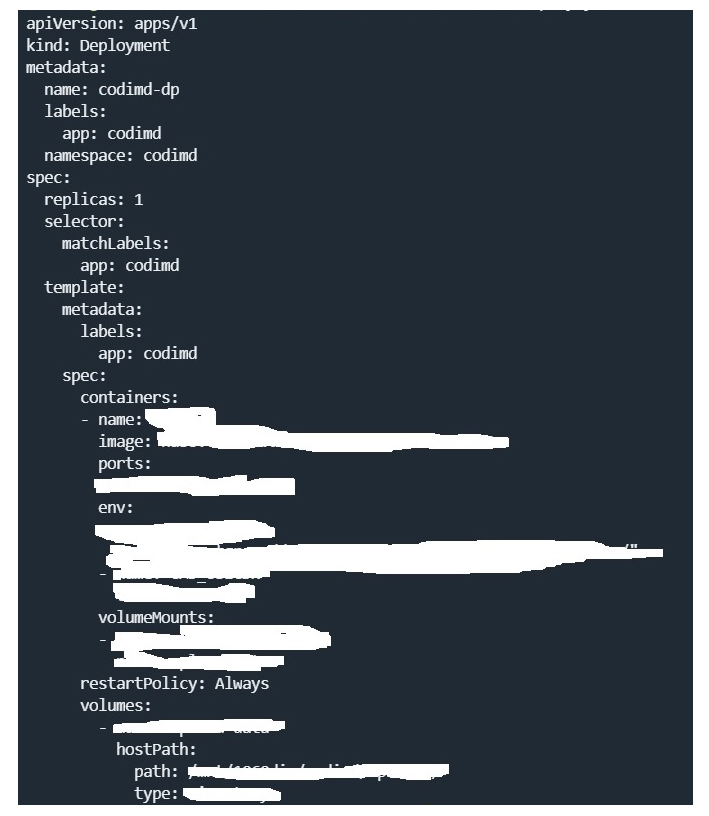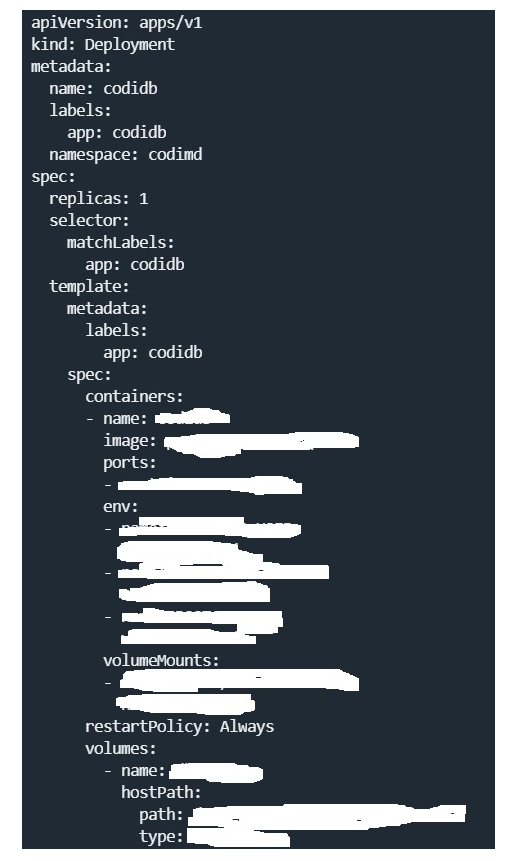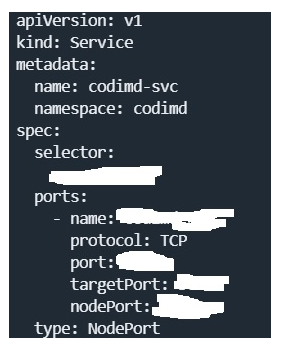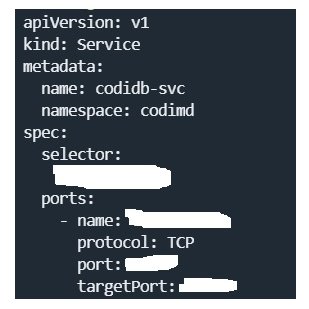- The first part help me get familiar with Dockerfile and how to install K3s.
- While I deployed the CodiMD servie using K8s in the second part. I used several yaml files to accomplish the task.
- Build a Docker image and run the container based on the image which I build on the K3s.
- Implement the app “CodiMD” with “CodiMD” and “postgresql” image by K8s’ Deployments and Pods.
- Make me more familiar with Docker and Pod which I build on the K3s.
- Create K8s services to provide service to users.
- Docker provides the ability to package and run an application in a loosely isolated environment called a container.
- The isolation and security allow me to run many containers simultaneously on a given host.
- Containers are lightweight because they don’t need the extra load of a hypervisor, but run directly within the host machine’s kernel.
- This means I can run more containers on a given hardware combination than if I am using virtual machines.
- I can even run Docker containers within host machines that are actually virtual machines!
- Docker is a tool that allows developers, sys-admins etc. to easily deploy their applications in a sandbox (called containers) to run on the host operating system i.e. Linux. (in this project os is ubuntu 20.04)
- The key benefit of Docker is that it allows users to package an application with all of its dependencies into a standardized unit for software development.
- Docker uses a client-server architecture. The Docker client talks to the Docker daemon, which does the heavy lifting of building, running, and distributing my Docker containers. The Docker client and daemon can run on the same system,
or you can connect a Docker client to a remote Docker daemon. The Docker client and daemon communicate using a REST API, over UNIX sockets or a network interface.
After introducing Docker, we will introduce Kubernetes. Additional information
- Docker provides tooling and a platform to manage the lifecycle of my containers:
- Develop my application and its supporting components using containers.
- The container becomes the unit for distributing and testing my application.
- When I’am ready, deploy my application into my production environment, as a container or an orchestrated service. This works the same whether my production environment is a local data center, a cloud provider, or a hybrid of the two.
- Docker provides the ability to package and run an application in a loosely isolated environment called a container. The isolation and security allow me to run many containers simultaneously on a given host.
- Containers are lightweight because they don’t need the extra load of a hypervisor, but run directly within the host machine’s kernel.
- K3s is a highly available, certified Kubernetes distribution designed for production workloads in unattended, resource-constrained, remote locations or inside IoT appliances.
- Because the K8s is too big and too complicated for new hand, so we will install K3s instead.
- K8s is a portable, extensible, open-source platform for managing containerized workloads and services, that facilitates both declarative configuration and automation.
- It has a large, rapidly growing ecosystem. Kubernetes services, support, and tools are widely available.
Containers are a good way to bundle and run your applications. In a production environment, I need to manage the containers that run the applications and ensure that there is no downtime. For example, if a container goes down, another container needs to start.
Wouldn’t it be easier if this behavior was handled by a system?
That’s how K8s comes to the rescue! K8s provides me with a frameworkto run distributed systems resiliently. It takes care of scaling and failover for my application, provides deployment patterns, and more. For example, K8s can easily manage a acanary deployment for my system.
K8s provides me with:
- Service discovery and load balancing: K8s can expose a container using the DNS name or using their own IP address. If traffic to a container is high, K8s is able to load balance and distribute the network traffic so that the deployment is stable.
- Storage orchestration: K8s allows me to automatically mount a storage system of your choice, such as local storages, public cloud providers, and more.
- Automated rollouts and rollbacks: You can describe the desired state for your deployed containers using K8s, and it can change the actual state to the desired state at a controlled rate. For example, I could automate K8s to create new containers for my deployment, remove existing containers and adopt all their resources to the new container.
- Automatic bin packing: I could provide K8s with a cluster of nodes that it can use to run containerized tasks. I could tell K8s how much CPU and memory (RAM) each container needs. K8s can fit containers onto my nodes to make the best use of my resources.
- Self-healing: K8s restarts containers that fail, replaces containers, kills containers that don’t respond to my user-defined health check, and doesn’t advertise them to clients until they are ready to serve.
- Secret and configuration management: K8s lets me store and manage sensitive information, such as passwords, OAuth tokens, and SSH keys. I can deploy and update secrets and application configuration without rebuilding my container images, and without exposing secrets in my stack configuration.
- K8s components:
- In a production environment, I need to manage the containers that run the applications and ensure that there is no downtime.
- K8s provides me with a framework to run distributed systems resiliently.
- CodiMD is the free software version of HackMD, developed and opened source by the HackMD team with reduced features (without book mode), I can use CodiMD for the community and own all my data.
- (See the origin of the name CodiMD.)
- CodiMD is perfect for open communities, while HackMD emphasizes on permission and access controls for commercial use cases.
- HackMD team is committed to keep CodiMD open source. All contributions are welcome!
Install Docker
sudo apt-get install docker.ioRestart Docker
sudo systemctl enable dockersudo systemctl restart dockerDocker user guide
sudo docker --helpPs:
Docker common command:
docker rundocker builddocker psdocker createInstall K3s
Because the K8s is too big and too complicated for new hand, so we will install K3s instead.
curl -sfL https://get.k3s.io | INSTALL_K3S_EXEC="--docker --write-kubeconfig-mode 644 " sh -Check whether K3s is running without error
kubectl get all -APod
Pods are the smallest deployable units of computing that I can create and manage in Kubernetes. A Pod is a group of one or more containers, with shared storage/network resources, and a specification for how to run the containers.
#Creating a Pod:
apiVersion: v1
kind: Pod
metadata:
name: nginx
labels:
app: nginx
spec:
containers:
- name: nginx
image: nginx:1.14.2
ports:
- containerPort: 80Deployments
A Deployment provides declarative updates for Pods ReplicaSets. I describe a desired state in a Deployment, and the Deployment Controller changes the actual state to the desired state at a controlled rate. I can define Deployments to create new ReplicaSets, or to remove existing Deployments and adopt all their resources with new Deployments.
#Creating a Deployment:
apiVersion: apps/v1
kind: Deployment
metadata:
name: nginx-deployment
labels:
app: nginx
spec:
replicas: 3
selector:
matchLabels:
app: nginx
template:
metadata:
labels:
app: nginx
spec:
containers:
- name: nginx
image: nginx:1.14.2
ports:
- containerPort: 80Services
An abstract way to expose an application running on a set of Pods as a network service. With Kubernetes I don’t need to modify my application to use an unfamiliar service discovery mechanism. Kubernetes gives Pods their own IP addresses and a single DNS name for a set of Pods, and can load-balance across them.
#Creating a Service:
apiVersion: v1
kind: Service
metadata:
name: my-nginx
labels:
run: my-nginx
spec:
ports:
- port: 80
protocol: TCP
selector:
run: my-nginxAfter introducing K8s basic components which are Pod, Deployment, and Service. We can start to practice K8s.
To make me familiar with Docker and Pod, this homework topic is to build a Docker image and to run the container based on the image which I build on the K3s.
Goal: Build a gcc Docker image that print “hello, this is lab 04.” and running on the K3s.
| Steps | Description |
|---|---|
| Step 1 | Create a C language file that print "hello, this is lab 04." |
| Step 2 | Write a Dockerfile based on "gcc:10.2" image. |
| Step 3 | Build a Docker image whose name is "gcc:lab04". |
| Step 4 | Write a Pod yaml file that is running "gcc:lab04" image. |
Implement the app “CodiMD” with “CodiMD” and “postgresql” image by K8s’ Deployments and Pods, while create K8s’ Services to provide service to users.
Hints: CodiMD github, CodiMD Documentation
For example, using docker-compose to setup CodiMD
- Below is the Dockerfile example
- Dockerfile
version: "3"
services:
database:
image: postgres:11.6-alpine
environment:
- POSTGRES_USER=codimd
- POSTGRES_PASSWORD=change_password
- POSTGRES_DB=codimd
volumes:
- "database-data:/var/lib/postgresql/data"
restart: always
codimd:
image: nabo.codimd.dev/hackmdio/hackmd:2.2.0
environment:
- CMD_DB_URL=postgres://codimd:change_password@database/codimd
- CMD_USECDN=false
depends_on:
- database
ports:
- "3000:3000"
volumes:
- upload-data:/home/hackmd/app/public/uploads
restart: always
volumes:
database-data: {}
upload-data: {}-
According to the docker-compose file, I finished the work to create CodiMD service.
-
The following images are the hints for the implementation.
-
According to the hints about yamls, I finished the work to deploy CodiMD service.
